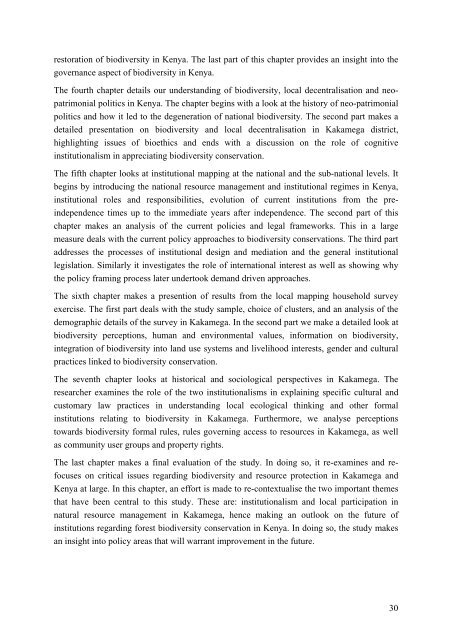THE UNIVERSITY OF LEIPZIG
THE UNIVERSITY OF LEIPZIG
THE UNIVERSITY OF LEIPZIG
Create successful ePaper yourself
Turn your PDF publications into a flip-book with our unique Google optimized e-Paper software.
estoration of biodiversity in Kenya. The last part of this chapter provides an insight into the<br />
governance aspect of biodiversity in Kenya.<br />
The fourth chapter details our understanding of biodiversity, local decentralisation and neo-<br />
patrimonial politics in Kenya. The chapter begins with a look at the history of neo-patrimonial<br />
politics and how it led to the degeneration of national biodiversity. The second part makes a<br />
detailed presentation on biodiversity and local decentralisation in Kakamega district,<br />
highlighting issues of bioethics and ends with a discussion on the role of cognitive<br />
institutionalism in appreciating biodiversity conservation.<br />
The fifth chapter looks at institutional mapping at the national and the sub-national levels. It<br />
begins by introducing the national resource management and institutional regimes in Kenya,<br />
institutional roles and responsibilities, evolution of current institutions from the preindependence<br />
times up to the immediate years after independence. The second part of this<br />
chapter makes an analysis of the current policies and legal frameworks. This in a large<br />
measure deals with the current policy approaches to biodiversity conservations. The third part<br />
addresses the processes of institutional design and mediation and the general institutional<br />
legislation. Similarly it investigates the role of international interest as well as showing why<br />
the policy framing process later undertook demand driven approaches.<br />
The sixth chapter makes a presention of results from the local mapping household survey<br />
exercise. The first part deals with the study sample, choice of clusters, and an analysis of the<br />
demographic details of the survey in Kakamega. In the second part we make a detailed look at<br />
biodiversity perceptions, human and environmental values, information on biodiversity,<br />
integration of biodiversity into land use systems and livelihood interests, gender and cultural<br />
practices linked to biodiversity conservation.<br />
The seventh chapter looks at historical and sociological perspectives in Kakamega. The<br />
researcher examines the role of the two institutionalisms in explaining specific cultural and<br />
customary law practices in understanding local ecological thinking and other formal<br />
institutions relating to biodiversity in Kakamega. Furthermore, we analyse perceptions<br />
towards biodiversity formal rules, rules governing access to resources in Kakamega, as well<br />
as community user groups and property rights.<br />
The last chapter makes a final evaluation of the study. In doing so, it re-examines and refocuses<br />
on critical issues regarding biodiversity and resource protection in Kakamega and<br />
Kenya at large. In this chapter, an effort is made to re-contextualise the two important themes<br />
that have been central to this study. These are: institutionalism and local participation in<br />
natural resource management in Kakamega, hence making an outlook on the future of<br />
institutions regarding forest biodiversity conservation in Kenya. In doing so, the study makes<br />
an insight into policy areas that will warrant improvement in the future.<br />
30






